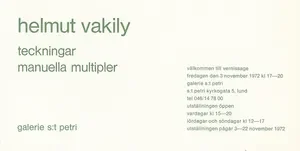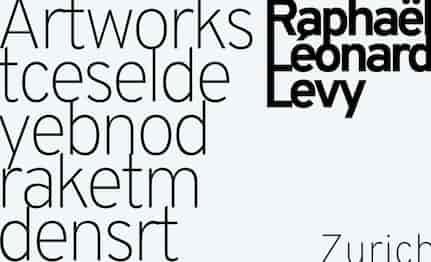CLICK TO VIEW PRESS RELEASE

HELMUT VAKILYTECKNINGAR MANUELLA MULTIPLER03-22.11.1972
Galerie S:t Petri
S:t Petri Kyrkogata 5
Lund
046 / 14 78 00
Between November 3 and 22, Helmut Vakily from Munich is showing about thirty drawings and manual multiples at Galerie S:t Petri.
It is the first time this German-Persian artist is exhibiting in Sweden. Raised in Tehran during the first ten years of his childhood, he came to Germany in 1949 and has lived there ever since.
Since 1963, he has had several solo exhibitions in Germany and has also participated in group exhibitions both nationally and internationally.
----------------------------------------------------------------------
Galerie S:t Petri
S:t Petri Kyrkogata 5
Lund
046 / 14 78 00
HELMUT VAKILY
3 – 22 November 1972
Vakily’s “Beautiful New World” is a dream, a utopia. One could even call it “science fiction,” except that this world is also acceptable to today’s humanity, i.e. it is humanistic in a modern sense. It is a world for man as a natural being, in which reason is ordered but where emotion and instinct also have their place. Vakily includes in his world man as an individual. He seeks to create within it a space for each human’s unique qualities. That is why he is so deeply engaged with psychology. That is why he so often paints his works “for someone.” The primordial principle of image-making, which constantly opposes the ordered, geometric, abstract, inorganic to the organic, flowing, informal, concrete, chaotic, is applied anew here, just as technology is set against the natural. It is only that contrast which Vakily considers insufficient as merely a complement.
In Vakily’s work, time is an essential component. We experience a connection or confrontation between different realms: between the interior and outer space, between the world and eternity. The feeling of time can also be experienced in the small scenes that are depicted side by side or beneath one another, showing the movement of time within an age, shaped by Einstein, who understood time as a dimension of space. This seems natural to us. Our century’s art, which began with Cubism, has shown us that this dimension can be expressed through artistic means. For him, time is not a measurable or ordered element, but has a differentiating and rhythmizing function. On the contrary, for Vakily, time is a flowing element, which encompasses and unites everything: humanity with eternity, the microcosm with the macrocosm. It is not only man who enters the painting, but man who stands before the painting — the viewer.
Thus the question of art is not only an image of existing reality. Often that is certainly the case. But just as often man creates in art a world of his own dreams, a better world, which in reality does not exist and perhaps cannot be realized. In this way, the world of art can help man to meditate and reflect: upon the world and upon himself. But the world of art can also give man the courage to take a stand, towards a world transformed. In this sense, Vakily’s “Beautiful New World” becomes more than merely an illusion or dream — it can be a source of inspiration. Vakily’s approach is very personal, not especially tied to trends or fashion. This could even be seen as anachronistic. Yet I am convinced that in today’s multifaceted art, his is a voice that should not go unheard.
Peter Spielman


